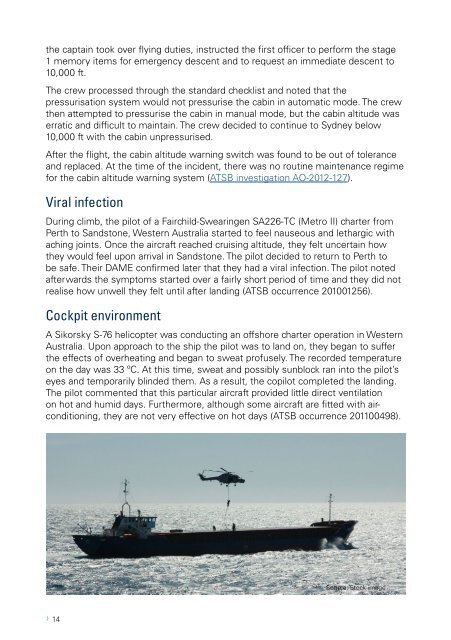Pilot incapacitation occurrences 2010–2014
8rKXy6YKY
8rKXy6YKY
You also want an ePaper? Increase the reach of your titles
YUMPU automatically turns print PDFs into web optimized ePapers that Google loves.
the captain took over flying duties, instructed the first officer to perform the stage<br />
1 memory items for emergency descent and to request an immediate descent to<br />
10,000 ft.<br />
The crew processed through the standard checklist and noted that the<br />
pressurisation system would not pressurise the cabin in automatic mode. The crew<br />
then attempted to pressurise the cabin in manual mode, but the cabin altitude was<br />
erratic and difficult to maintain. The crew decided to continue to Sydney below<br />
10,000 ft with the cabin unpressurised.<br />
After the flight, the cabin altitude warning switch was found to be out of tolerance<br />
and replaced. At the time of the incident, there was no routine maintenance regime<br />
for the cabin altitude warning system (ATSB investigation AO-2012-127).<br />
Viral infection<br />
During climb, the pilot of a Fairchild-Swearingen SA226-TC (Metro II) charter from<br />
Perth to Sandstone, Western Australia started to feel nauseous and lethargic with<br />
aching joints. Once the aircraft reached cruising altitude, they felt uncertain how<br />
they would feel upon arrival in Sandstone. The pilot decided to return to Perth to<br />
be safe. Their DAME confirmed later that they had a viral infection. The pilot noted<br />
afterwards the symptoms started over a fairly short period of time and they did not<br />
realise how unwell they felt until after landing (ATSB occurrence 201001256).<br />
Cockpit environment<br />
A Sikorsky S-76 helicopter was conducting an offshore charter operation in Western<br />
Australia. Upon approach to the ship the pilot was to land on, they began to suffer<br />
the effects of overheating and began to sweat profusely. The recorded temperature<br />
on the day was 33 oC. At this time, sweat and possibly sunblock ran into the pilot’s<br />
eyes and temporarily blinded them. As a result, the copilot completed the landing.<br />
The pilot commented that this particular aircraft provided little direct ventilation<br />
on hot and humid days. Furthermore, although some aircraft are fitted with airconditioning,<br />
they are not very effective on hot days (ATSB occurrence 201100498).<br />
Source: Stock image<br />
› 14


